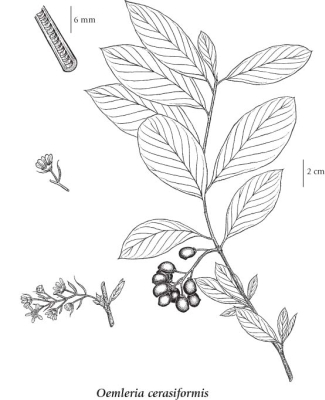Oemleria cerasiformis (Torr. & A. Gray ex Hook. & Arn.) Landon
osoberry (osoberry)
Rosaceae (Rose family)
Introduction to Vascular Plants
osoberry (osoberry)
Rosaceae (Rose family)
Introduction to Vascular Plants
Photograph
© Kent Brothers (Photo ID #116)
Species Information
General:
Medium to tall shrub, 1-5 m tall; stems clumped, arching; pith chambered; bark bitter, purplish-brown.
Leaves:
Alternate, deciduous, lanceolate to oblong-egg-shaped or elliptic, short-stalked, the stalks 5-10 mm long, the blades 5-12 cm long, not toothed, pale green and smooth above, paler and often sparsely hairy below; crushed leaves smell like cucumber.
Flowers:
Inflorescences loose, drooping, bracted, 5- to 10-cm long clusters, at the ends of short axillary branchlets, of several (5 to 10) stalked flowers; flowers mostly unisexual, the male and female flowers on separate plants, appearing very early in the year, as the leaves develop; corollas greenish-white, saucer- to cup-shaped, about 1 cm across, the petals 5, egg-shaped, 5-6 mm long, spreading (shorter, narrower and erect on female flowers); calyces 6-7 mm long, 5-lobed, the lobes about equalling the top-shaped hypanthium; ovaries (female plants) usually 5, superior; stamens 15.
Fruits:
Fleshy drupes, like small plums with a large stone, bean-shaped, about 1 cm long, peach-coloured, ripening to bluish-black with a whitish bloom, 1 to 5 per female flower; seeds 1 per drupe.
Illustration

If more than one illustration is available for a species (e.g., separate illustrations were provided for two subspecies) then links to the separate images will be provided below. Note that individual subspecies or varietal illustrations are not always available.
Illustration Source: The Illustrated Flora of British Columbia
USDA Species Characteristics
Flower Colour:
White
Blooming Period:
Spring
Fruit/Seed characteristics:
Colour: Purple
Present over the
Source: The USDA
Ecology
Ecological Framework for Oemleria cerasiformis
The table below shows the species-specific information calculated from
original data (BEC database) provided by the BC Ministry of Forests and Range.
(Updated August, 2013)
The table below shows the species-specific information calculated from
original data (BEC database) provided by the BC Ministry of Forests and Range.
(Updated August, 2013)
| Site Information |
Value / Class |
||
|
Avg |
Min |
Max |
|
| Elevation
(metres) |
45 | 1 | 500 |
| Slope
Gradient (%) |
10 | 0 | 84 |
|
Aspect (degrees) |
35 | 45 | 360 |
| Soil
Moisture Regime (SMR) [0 - very xeric; 4 - mesic; 8 - hydric] |
5 | 1 | 7 |
| Modal
Nutrient Regime
Class |
D | ||
| #
of field plots species was recorded in: |
165 | ||
| Modal
BEC Zone Class |
CDF | ||
|
All BEC Zones (# of stations/zone) species was recorded in |
CDF(158), CWH(7) | ||
|
Source:
Klinkenberg 2013
|
|||
Habitat and Range
Moist to dry open forests, forest edges, thickets, streambanks, clearings and roadsides in the lowland zone; frequent on S Vancouver Island, the Gulf Islands and the adjacent mainland; S to N CA.Status Information
Synonyms
Synonyms and Alternate Names:
Nuttallia cerasiformis Torr. & A. Gray ex Hook. & Arn.
Osmaronia cerasiformis (Torr. & A. Gray ex Hook. & Arn.) Greene